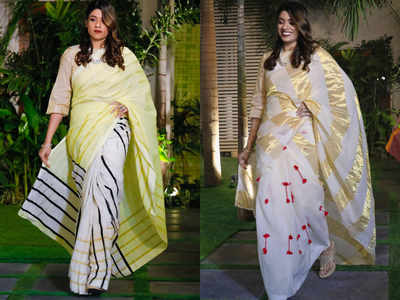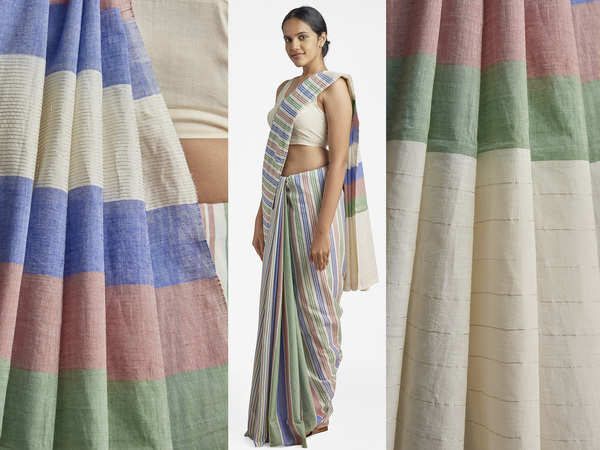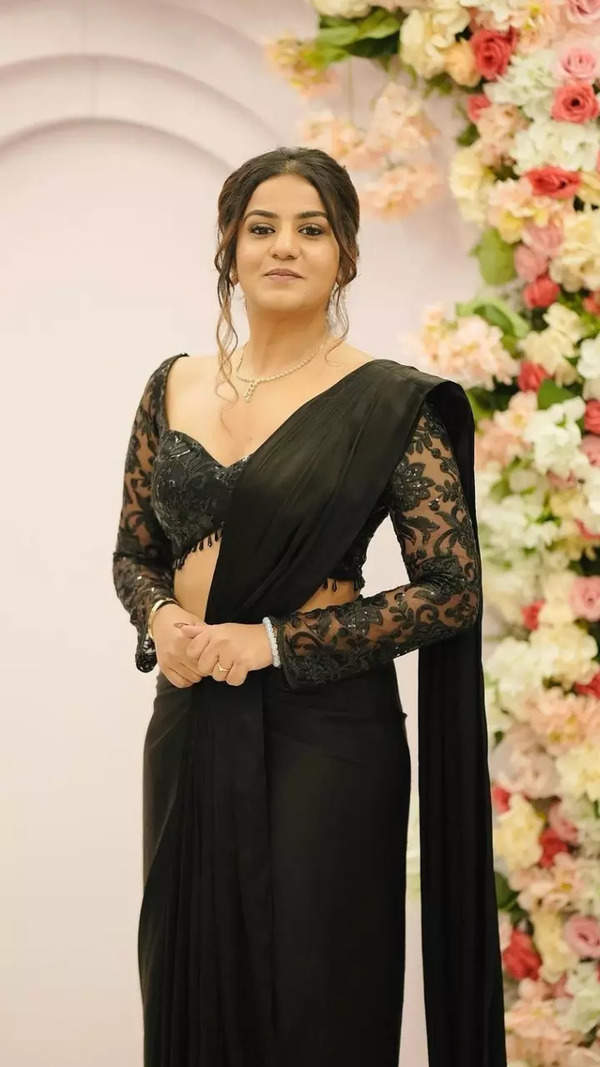Trending
This story is from August 30, 2020
Reimagining Kerala's classic sari - the kasavu
When you think of Indian handlooms, a lush Banarasi brocade, eye-catching hues of a patan patola or the myriad mix of pochampally ikat spring to mind instantly.

When you think of Indian handlooms, a lush Banarasi brocade, eye-catching hues of a patan patola or the myriad mix of pochampally ikat spring to mind instantly. Somewhere, tucked in a corner, stands Kerala’s traditional kasavu sari – a piece that is demonstrates visual restraint. And therein, probably lie its gift and its curse. Kochi-based designer Sreejith Jeevan of Rouka – who is working to create new iterations to this classic – says that the Kerala kasavu is a souvenir.
“Everyone knows that ‘white and gold’ is Kerala sari. But that’s about it. So it is indeed popular and a must have. But I feel that’s where it stops,” he says. After all, if you have one white and gold sari, you would probably not want another. A reason why, designers and weavers across Kerala are reimagining the kasavu sari – just in time for Onam (August 31).
 (Save the Loom project)
(Save the Loom project)
In 2019, at The Kochi Muziris Biennale, Menon – a regular of the fashion world courtesy his past association with Fashion Design Council of India – got 20 designers including Abraham & Thakore, Rajesh Pratap Singh, Ujjwal Dubey, Aneeth Arora among others to reimagine the Kerala mundu, thorthu (small stole) and sari and opened a pop-up shop, One Zero Eight, at Fort Kochi. The response was good. He mentions how the then head of MoMA (The Museum of Modern Art) bought three sets. “After the floods, there was a need to tell a new tale. It’s a fact that interpretations bring greater value,” he notes. It’s also a way to ensure that the weavers get better value for their work. Kerala-based designers like Jeevan, Poornima Indrajith of Pranaah among others are at it. Even weavers – be it at Balaramapuram, Chendamangalam and Kuthampully (the three hubs of kasavu weaving) – are adding new designs and colours.
Menon says that the kasavu needs to be reworked so that it moves beyond the staple of festivals like Onam, Vishu and weddings. In 2004, designer Rahul Mishra had worked with the kasavu to create Western silhouettes. While designers have worked with it but it stays for a collection or two and then they move to the next big hit. Menon adds, “There’s a gap between what designers do and how it contributes to changing dynamic of a grassroots’ weaver.” They don’t change the backend – for that a sustained effort is needed.
Jeevan says, “Every weave in this country has survived because it has tried to stay relevant. Banarsies are modern, chanderies are stylish, ikats have become such essentials, bandhani has gone the contemporary route. Crafts have to find ways to make its avatars to stay relevant.” For kasavu sari weavers to stay relevant, it has to find meaning with people. As Menon comments that it’s difficult to preserve traditional form with no consumers.
A good rework according to Jeevan is to keep the skills traditional so that the weaver shouldn’t feel they are making something else. The bottom line: it’s an attempt to make another dish with the same ingredients, like adding a tweak to your regular dal to make it less monotonous. He adds, “We only tweak it till the point we know it still gives the feeling of a Kerala kasavu sari in spite of knowing that it is a contemporary hybrid.”
 (A Kuthampully sari)
(A Kuthampully sari)
Thumb Photo: Sreejith Jeevan creations
“Everyone knows that ‘white and gold’ is Kerala sari. But that’s about it. So it is indeed popular and a must have. But I feel that’s where it stops,” he says. After all, if you have one white and gold sari, you would probably not want another. A reason why, designers and weavers across Kerala are reimagining the kasavu sari – just in time for Onam (August 31).

A sari state of affairs
When Ramesh Menon started out his social enterprise Save The Loom in 2018, in the aftermath of the devastating Kerala floods, he was not particularly looking to reinvent the kasavu sari. His idea was much larger – to provide process management to the handloom sector through design interventions, skill upgradation, technical support and more. All this so that the weavers get better work conditions, visibility and remunerations and, Menon adds, “A big push was to create dignity for their work so that the new generation takes to it with pride.”
In 2019, at The Kochi Muziris Biennale, Menon – a regular of the fashion world courtesy his past association with Fashion Design Council of India – got 20 designers including Abraham & Thakore, Rajesh Pratap Singh, Ujjwal Dubey, Aneeth Arora among others to reimagine the Kerala mundu, thorthu (small stole) and sari and opened a pop-up shop, One Zero Eight, at Fort Kochi. The response was good. He mentions how the then head of MoMA (The Museum of Modern Art) bought three sets. “After the floods, there was a need to tell a new tale. It’s a fact that interpretations bring greater value,” he notes. It’s also a way to ensure that the weavers get better value for their work. Kerala-based designers like Jeevan, Poornima Indrajith of Pranaah among others are at it. Even weavers – be it at Balaramapuram, Chendamangalam and Kuthampully (the three hubs of kasavu weaving) – are adding new designs and colours.
Old sari in new form?
Menon says that the kasavu needs to be reworked so that it moves beyond the staple of festivals like Onam, Vishu and weddings. In 2004, designer Rahul Mishra had worked with the kasavu to create Western silhouettes. While designers have worked with it but it stays for a collection or two and then they move to the next big hit. Menon adds, “There’s a gap between what designers do and how it contributes to changing dynamic of a grassroots’ weaver.” They don’t change the backend – for that a sustained effort is needed.
Jeevan says, “Every weave in this country has survived because it has tried to stay relevant. Banarsies are modern, chanderies are stylish, ikats have become such essentials, bandhani has gone the contemporary route. Crafts have to find ways to make its avatars to stay relevant.” For kasavu sari weavers to stay relevant, it has to find meaning with people. As Menon comments that it’s difficult to preserve traditional form with no consumers.
A good rework according to Jeevan is to keep the skills traditional so that the weaver shouldn’t feel they are making something else. The bottom line: it’s an attempt to make another dish with the same ingredients, like adding a tweak to your regular dal to make it less monotonous. He adds, “We only tweak it till the point we know it still gives the feeling of a Kerala kasavu sari in spite of knowing that it is a contemporary hybrid.”

Know our kasavu
What is a kasavu sari?
Kasavu is actually zari used in Kerala sari, mundu or thorthu, etc.Where is it made?
Kerala. It has three clusters that have been given a Geographical Indication (GI) tag – Balaramapuram, Chendamangalam and Kuthampully. Balaramapuram is famous for its use of pure zari.How much does it cost?
A wedding kasavu can cost more than Rs 1.5 lakh. A plain kasavu can start at Rs 3000.Is it always handloom?
It was. But now one finds more powerloom (also cheaper) options. In Kerala, handloom saris are called Kaithari. Kai is hand and thari means loom.What’s the design?
The Kerala sari and mundus are very minimalistic, are predominantly white with a plain weave on the body. The only design element is the border. The thickness of the border makes the sari festive or funereal.Is it always on a cotton base?
Yes. Kasavu saris are always cotton, marrying comfort with grandeur. Thumb Photo: Sreejith Jeevan creations
End of Article
FOLLOW US ON SOCIAL MEDIA








